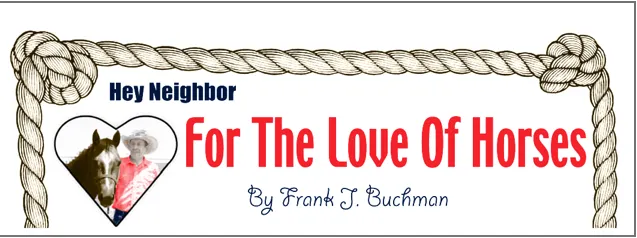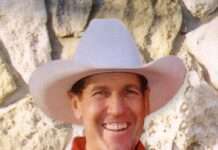Renowned Auctioneer Verlin Green Climaxes
Lifetime Career Serving Livestock Auctions
By Frank J. Buchman
It’s a livestock auctioneering career likely qualifying for the Guinness Book of World Records.
When Col. Verlin Green dropped the gavel July 24th, it was culminating climax of 57 years serving the auction block.
Claiming he’s completed his lifetime profession the nearly 84-years-old Perry auctioneer’s official last day of work was at Overbrook Livestock.
“I’d worked there 26 years, but I’ve also sold at a couple handfuls of auction barns through the years. Several longer than that, plus a lot of farm sales and other auctions,” Green reflected.
“It was time to stop while I was still satisfying the sellers, buyers and auction barn owners. This’ll give me more time to run the hounds,” Green added.
In apparent sound health, good voice, hearing and eyesight recovering nicely from cataract work. “I’m doing quite well,” he assured.
“It’s been a good day. A friend and I just ran seven hounds for five hours or so. I just love their music when they pick up a scent,” Green claimed.
Brief clarification, Green takes his Beagles out three or four times a week, usually four female dogs of his own. “They’ll get on a rabbit, start howling and get that rabbit circling until he goes into cover,” Green explained.
It’s all for the sport of the chase watching and listening to the hounds not bagging the prey. “I’d never shoot a rabbit, and then there wouldn’t be any more excitement for the chase,” he smiled.
Growing up at Perry, Green said, “My dad handled cattle, did some buying and selling, I’d go to the sales with him. The auctioneers fascinated me, and I’d practice auctioneering on my own, act like I was selling cattle.”
He’d also sometimes get to ride around with Johnny Ross a local trucker who heard him practicing the auction chant.
“Johnny said, ‘Verlin you’re really good for a kid. You ought to take up the auction profession.’ And by gosh that’s what I decided to do,” Green reflected.
“In my greatest imagination I never dreamed it’d turn out like it did. All these years as an auctioneer, all those sales and the millions of cattle sold,” he added.
Officially perfecting his auctioneering skills, Green attended and graduated from the Missouri Auction School in Kansas City. “I came home and went to work as an auctioneer for the Farmers Livestock Exchange at Wakarusa,” he remembered.
The once-a-week auction garnered attention from buyers, sellers and other auction barn owners seeking his services.
“I kept having people asking me to conduct their farm sales and household auctions. I got so I was doing a lot of them, but I preferred working the sale barns,” Green said.
“There was one stretch with sale barns and local weekend auctions I sold for 30 days straight,” he counted.
Proof of his masterful skill of the auction chant profession came when Green started teaching at his alma meter.
“I taught at the Missouri Auction School for 15 years. That was a great experience helping train so many the skills of the auction business,” he said.
In the early ’70s, Green went to work for Kansas City Stockyards. “I’ll tell you that was an operation. I worked there 20 years,” Green said. “They had three sales a week starting out then went to four days and I also sold at Emporia Livestock on Friday.”
Such demands can be straining on the voice, hearing and eyes, but there was systematic rotation among Kansas City auctioneers.
“We were selling lots of cattle back in the ’70s. With killer cows Monday, smaller drafts Tuesday and Wednesday we’d sell from a thousand to twenty five hundred a day. Auctioneers would trade off every 100 lots,” Green tallied.
Biggest day was Thursday with 6,000 sometimes more than 10,000 cattle sold.
“We didn’t sell any singles, at least five head in a draft, so we’d trade off working the block every 60 drafts,” Green said. “Sometimes, we’d go into the wee hours of the morning. I’d get home two or three hours and have to be back working an auction.”
Besides Emporia, Kansas City, Overbrook and Wakarusa, Green worked regular stints for several years each at other auction barns. That included Council Grove, St. Marys, Kingsville (Missouri), Lawrence and Waverly. “I worked at Emporia for 36 years,” he noted.
Selling purebred cattle auctions is a niche all its own and Green served that trade as well. “I sold Hamm’s N R Bar Angus Sale several years,” Green said. “I was friends with the nationally prominent Angus auctioneer Ray Sims and worked with Ray at a number of big Angus auctions.”
Green also served as ring man bid taker at purebred sales working for livestock publications including the Kansas Stockman.
Called on to sell youth premium auctions at several area county fairs, highlight was selling American Royal champions.
“They had Roy Clark come sell the grand champion there one time, but he didn’t know how to auction. I coached Roy before the sale, helped him along during the auction and it turned out fine,” Green said.
An occasional horse sale was added to Green’s busy schedule.
With his longevity in the cattle auction business, Green has seen high and low prices. “Cattle were only 20 cents a pound when I started in the ’60s,” he recalled. “Then the price got up to more than $3 a pound three or four years ago.
“The cattle being sold now have more height and length than when I started selling,” Green pointed out.
A mentor to inspiring and successful auctioneers, Green remembers becoming acquainted with Wayne Wischropp.
“He was just getting started and called me when I was selling the Council Grove barn. I stopped by Lyndon on my way home and helped Wayne line up his first big auction,” Green said. “Wayne and I’ve worked together a lot through the years. I helped him and Charles Beatty out several times when they had that consignment sale at Osage City.”
Darwin Kurtz, Westphalia auctioneer, credits Green for getting him into the profession. “I was totally fascinated with Verlin Green at Kansas City in the early ’70s,” Kurtz said. “When they’d switch auctioneers, Verlin started tapping his trademark block of wood and a dead market suddenly came to life.
“His fast rhythmic punches of words and spontaneous noise tapping the block were totally unique to Verlin Green,” Kurtz recognized.
Dean Moore and Jude Carey were a couple auctioneers Green mentioned as personal inspiration for his profession.
The old saying “Behind every successful man is a strong woman” is verified by Col. Verlin Green. “Connie and I have been married 61 years. Along with her jobs away from home, Connie has always taken care of me.
“Whenever I’d get back, she’d have meals on the table, get my clothes ready and I’d be gone again. I couldn’t have done any of this without Connie,” Green credited.
“Verlin is well known for sparking up an auction,” Connie insisted. “He’s quite the jokester, always having fun and enjoying the people.”
The couple has two children: Cristy Green Bidinger of Perry and Kyle Green of Lawrence.
“We have five grandchildren and five great grandchildren. We’re so proud of them all. They’re the highlight of our lives these days,” Green declared.
Unlike others often tied to the livestock auction business, Green hasn’t handled many cattle of his own. “I had some cattle in the early years, but there just wasn’t time being on the road all of the time,” Green said. “I never speculated bought and traded cattle, wasn’t even tempted; it has sure backfired on some.”
Previously enjoying hunting ’coons, Green rode mules as his hounds worked. “I had some good mules, and enjoyed them a lot, too” said Green, former leader in the Midwest Mule Club.
While he also used to hunt coyotes with dogs, Green has found most enjoyment from his Beagles.
“I raised pups and trained Beagle hounds for a number of years,” he said. “Of course, quality food is essential for dogs to work their best. So I developed and commercially produced my own line of dog food.
Green’s High Power Dog Food Company attracted patronage from a wide area. “It was a good sideline business for 20 years until I sold the company,” Green said.
Stringency of the occupation threatened Green in 1977 as he suffered a heart attack when he was 41-years-old.
“The doctor didn’t have any trouble figuring out the cause when I told him what I did,” Green commented. “But I was back selling auctions in three months and fortunately haven’t had any of those issues since.
“My goal in the auction business was to satisfy the sale barn owners, the consigners, and the buyers,” Green confirmed.
Certainly, Col. Verlin Green is the one for the records in the livestock auctioneering business.
CUTLINES
A most familiar sight was Col. Verlin Green of Perry in the auction box selling cattle. This was during the last sale at the Kansas City Stockyards on September 26, 1991.
As Col. Verlin Green of Perry worked as an auctioneer for 57 years, wife Connie kept the home fires burning. They’ve been married 61 years. “I couldn’t have done any of it without Connie,” Green credited
Cattle prices and types have verified considerably in the nearly six decades Col. Verlin Green, Perry, has worked auction barns.






